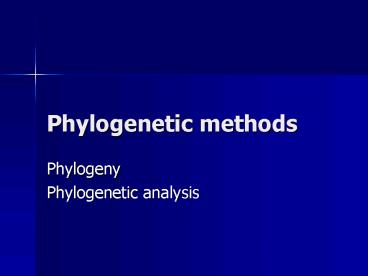Phylogenetic methods - PowerPoint PPT Presentation
1 / 25
Title: Phylogenetic methods
1
Phylogenetic methods
- Phylogeny
- Phylogenetic analysis
2
Phylogenetics
- Linnaeuss system systematicist not
evolutionist - Darwin using Linnaeuss classification
hierarchy - Phylogeny the evolutionary relationship between
organisms - Character-based morphological features
(limitation?) - Serological reaction (Ab cross-reactivity)
Nuttall - Protein electrophoresis similarity in protein
properties - DNA-DNA hybridization
- Sequencing protein and DNA
3
Advantages of molecular phylogenetics
- Large datasets A, T, C, G for character states,
every position is one character - Unambiguous not like shape or length
(morphology/phenotypes) (convergent evolution) - No suitable phenotypes to compare, e.g. compare
among bacteria or between bacteria and flies - Easy to convert to numerical form for
mathematical analysis
4
Phylogenetic trees
- Distance-based a measure of overall, pairwise
difference between two data sets, e. g. scores
from alignments - Character-based use a well-defined feature that
exists in a limited number or different states,
e. g. A, T, C, G anatomical/behavioral
phenotypes - character data can be converted to distance data
5
- Pheneticist prefer mathematic-based methods,
emphasize on relationship among data sets - Cladist prefer biology-based (character)
methods, emphasize on evolutionary pathways and
patterns - unequal weighted characters
6
DNA-based phylogenetics
- Higher information content display synonymous
substitutions - Variability in non-coding regions also can be
examined - Easy sampling and sequencing
7
Terminology
8
(No Transcript)
9
Information inferred from the tree horizontal
gene transfer
xenolog
10
(No Transcript)
11
(No Transcript)
12
(No Transcript)
13
ingroups
Assigned by constructor, use other
information/knowledge
14
(No Transcript)
15
Gene vs. species trees
16
Distance matrix methods
Pairwise distance
- UPGMA
Calculate the new matrix d(AB)C1/2(dACdBC) d(AB)
D1/2(dADdBD)
cluster the smallest distance pair
17
Cluster first
18
(No Transcript)
19
- Topology of the tree
- branch pattern relatedness of the taxon
- branch length inferred time of divergence
- cladogram
20
Estimation of branch length
x (dAB dAC - dBC )/2 y (dAC dBC - dAB
)/2 z (dBC dAB - dAC )/2
21
Tree confidence
- How much confidence for each branch
- How much more likely is one tree to be correct
than a random alternative tree - Bootstrapping
- What do bootstrap values mean?
- Bootstrap values for phylogenetic trees do not
follow standard statistical behaviour. - Bootstrap value of 95 is actually close to 100
confidence in that branch. - Bootstrap value of 75 often close to 95
confidence. - Bootstrap value of 60 is much lower confidence.
- Less than 50 bootstrap no confidence in that
branch over an alternative.
22
(No Transcript)
23
Procedures of tree reconstruction
- Sequence alignment
- find homologs, not overrepresent or
underrepresent the sequences - perform alignment parameter setting
- make a guide tree first, align close related
sequences first - place indels at correct positions
- Convert alignment data into a phylogenetic tree
- choose tree methods
- Assess the accuracy of a reconstructed tree
- bootstrap analysis
- Estimate branch length
- calibration with other data
clustalW
clustalW
Use TreeView to view the tree output
24
Tree of life
- The deep evolutionary differences in archaea and
bacteria only can be revealed from molecular data
25
Human origins
- Data from mtDNA 0.33 sequences difference
among ethic groups (5 between orangutan
subspecies) - African populations display greatest differences
Human originate from Africa - Y-chromosome data also support out-of-Africa
theory - Mitochondrial Eve Y-chromosome Adam 200,000
years ago































